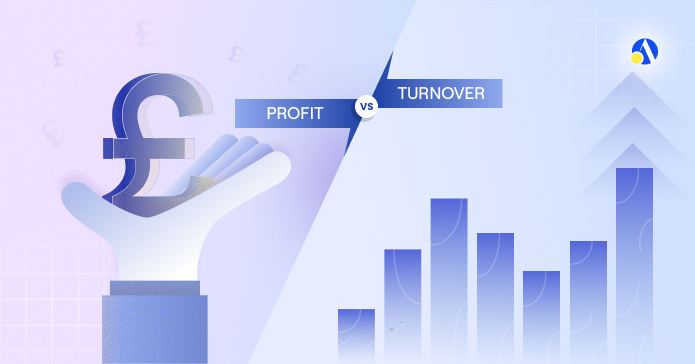When running a business, you'll often hear the financial terms 'turnover' and 'profit'. While both relate to your company's performance, they measure different things. Confusing them is a common mistake, but knowing the difference is essential for making sound business decisions.
So, what is the difference between turnover and profit? Turnover is the total amount of money your business receives from sales, while profit is the money left after you've paid all your business expenses.
This guide will break down these concepts to help you better understand your business's finances.
What is Turnover?
Turnover, also known as revenue or sales, is the total income a business generates from its sales over a specific period (e.g., a month, quarter, or year). It represents the full value of your sales before deducting any expenses.
Think of turnover as the top-line figure on your income statement. A high turnover often indicates strong demand for your products or services and effective sales and marketing strategies.
Turnover Example:
Imagine you own a coffee shop. In one month, you sell £10,000 worth of coffee, cakes, and sandwiches.
Your turnover for that month is £10,000.
What is Profit?
Profit, on the other hand, is the money left over after you subtract all your business expenses from your turnover. This is your "bottom line"—the true measure of your business's financial health. So, what’s the difference between gross and net profit?
What is Gross Profit?
Gross profit is your turnover minus the direct costs of making your products or delivering your services. These direct costs are called the Cost of Goods Sold (COGS). They cover expenses like raw materials and inventory.
Gross Profit Example:
Continuing with the coffee shop example, your turnover was £10,000. Let's say the coffee beans, milk, bread, and other ingredients cost you £3,000.
- Gross Profit Formula: Turnover - Cost of Goods Sold
- Calculation: £10,000 - £3,000 = £7,000 Gross Profit
What is Net Profit?
Net profit provides the full financial picture. It's the amount left after deducting all business expenses from your turnover, including direct costs (COGS) and indirect costs (overheads). Overheads like rent, staff wages, marketing, and utility bills are examples of these indirect costs.
Net Profit Example:
Your coffee shop's gross profit was £7,000. On top of the £3,000 for ingredients, you also had other expenses for the month:
- Rent: £1,500
- Staff wages: £2,500
- Utilities and marketing: £500
- Total Overheads: £4,500
- Net Profit Formula: Gross Profit - Overheads
- Calculation: £7,000 - £4,500 = £2,500 Net Profit
Your Questions Answered
How much of turnover is profit?
There's no single answer. The profit you generate from your turnover is determined by your business model, industry, and how effectively you manage expenses. For example, a business with high operating costs might have a low profit margin, even if its turnover is high.
Imagine a small retail business with the following figures:
- Monthly Revenue (Turnover): £20,000
- Cost of Goods Sold (COGS): £12,000
- Gross Profit Calculation: £20,000 (Turnover) - £12,000 (COGS) = £8,000 Gross Profit
Now, accounting for overhead costs like rent, utilities, marketing, and staff wages:
- Overheads: £5,000
- Net Profit Calculation: £8,000 (Gross Profit) - £5,000 (Overheads) = £3,000 Net Profit
This example illustrates how turnover is only one part of the equation, as your profit depends heavily on managing costs and optimizing expenses.
How do you calculate turnover to profit?
To see how efficiently your business turns revenue into profit, you can calculate your net profit margin. This shows your net profit as a percentage of your turnover.
- Net Profit Margin Formula: (Net Profit / Turnover) x 100
- Example: (£2,500 / £10,000) x 100 = 25%
This means for every £1 of sales, you made 25p in profit.
How many times turnover is a business worth?
A business's value isn't usually determined by turnover alone. Instead, valuations often rely on a multiple of net profit or a metric like EBITDA (Earnings Before Interest, Taxes, Depreciation, and Amortisation).
This multiple can change significantly based on the industry, growth potential, and current market conditions. For this reason, a business with a high turnover but low profit might be valued less than a business with lower turnover but a higher profit margin.
Is turnover or profit more important?
Both are important, but for different reasons.
- Turnover shows the scale of your business and its market position. It proves there is a demand for your product.
- Profit shows the financial health and sustainability of your business. It proves your business model actually works.
A business can't survive long-term without profit, no matter how high its turnover. As the saying goes, "Turnover is vanity, profit is sanity."
Master Your Business Finances
Understanding the difference between turnover and profit is essential for building a successful, sustainable business. Tracking both allows you to make smarter decisions about pricing, cost management, and growth strategies.
Want to dive deeper into business basics? Check out our blog for simple, practical guides to help entrepreneurs succeed.
For more information watch the video here













